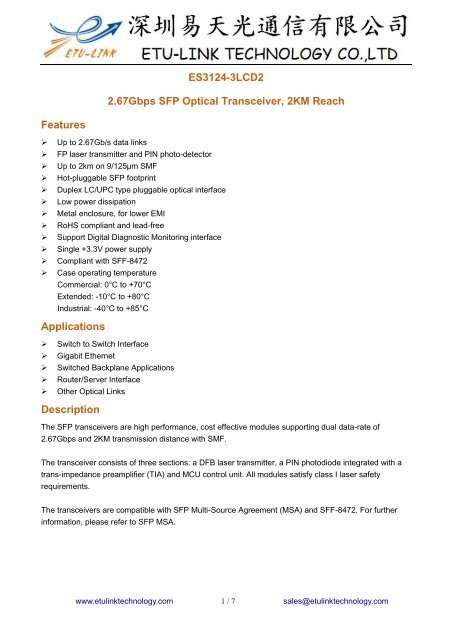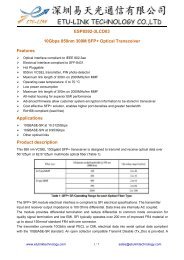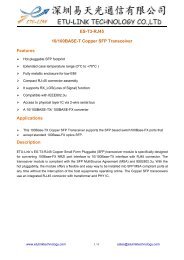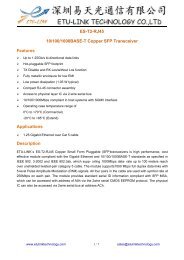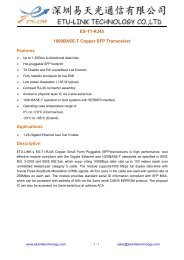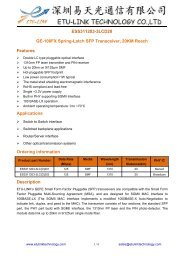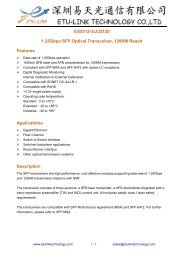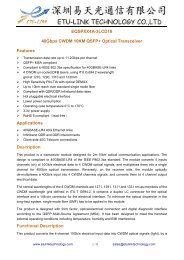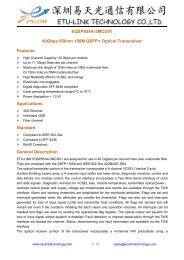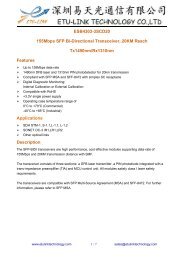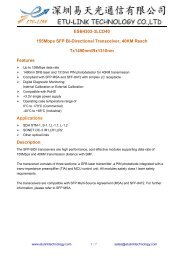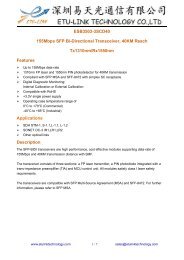ES3124-3LCD2
The SFP transceivers are high performance, cost effective modules supporting dual data-rate of 2.67Gbps and 2KM transmission distance with SMF. The transceiver consists of three sections: a DFB laser transmitter, a PIN photodiode integrated with a trans-impedance preamplifier (TIA) and MCU control unit. All modules satisfy class I laser safety requirements. The transceivers are compatible with SFP Multi-Source Agreement (MSA) and SFF-8472. For further information, please refer to SFP MSA.
The SFP transceivers are high performance, cost effective modules supporting dual data-rate of
2.67Gbps and 2KM transmission distance with SMF.
The transceiver consists of three sections: a DFB laser transmitter, a PIN photodiode integrated with a
trans-impedance preamplifier (TIA) and MCU control unit. All modules satisfy class I laser safety
requirements.
The transceivers are compatible with SFP Multi-Source Agreement (MSA) and SFF-8472. For further
information, please refer to SFP MSA.
You also want an ePaper? Increase the reach of your titles
YUMPU automatically turns print PDFs into web optimized ePapers that Google loves.
<strong>ES3124</strong>-<strong>3LCD2</strong><br />
2.67Gbps SFP Optical Transceiver, 2KM Reach<br />
Features<br />
‣ Up to 2.67Gb/s data links<br />
‣ FP laser transmitter and PIN photo-detector<br />
‣ Up to 2km on 9/125µm SMF<br />
‣ Hot-pluggable SFP footprint<br />
‣ Duplex LC/UPC type pluggable optical interface<br />
‣ Low power dissipation<br />
‣ Metal enclosure, for lower EMI<br />
‣ RoHS compliant and lead-free<br />
‣ Support Digital Diagnostic Monitoring interface<br />
‣ Single +3.3V power supply<br />
‣ Compliant with SFF-8472<br />
‣ Case operating temperature<br />
Commercial: 0°C to +70°C<br />
Extended: -10°C to +80°C<br />
Industrial: -40°C to +85°C<br />
Applications<br />
‣ Switch to Switch Interface<br />
‣ Gigabit Ethernet<br />
‣ Switched Backplane Applications<br />
‣ Router/Server Interface<br />
‣ Other Optical Links<br />
Description<br />
The SFP transceivers are high performance, cost effective modules supporting dual data-rate of<br />
2.67Gbps and 2KM transmission distance with SMF.<br />
The transceiver consists of three sections: a DFB laser transmitter, a PIN photodiode integrated with a<br />
trans-impedance preamplifier (TIA) and MCU control unit. All modules satisfy class I laser safety<br />
requirements.<br />
The transceivers are compatible with SFP Multi-Source Agreement (MSA) and SFF-8472. For further<br />
information, please refer to SFP MSA.<br />
www.etulinktechnology.com 1 / 7 sales@etulinktechnology.com
Module Block Diagram<br />
Absolute Maximum Ratings<br />
Parameter Symbol Min Typ Max Unit Ref.<br />
Maximum Supply Voltage Vcc -0.5 4.7 V<br />
Storage Temperature TS -40 85 °C<br />
Case Operating Temperature TOP 0 70 °C<br />
Electrical Characteristics (TOP = 0 to 70℃, VCC = 3.15 to 3.60Volts)<br />
Parameter Symbol Min Typ Max Unit Ref.<br />
Supply Voltage Vcc 3.15 3.3 3.6 V<br />
Supply Current Icc 185 250 mA<br />
Transmitter<br />
Input differential impedance Rin 100 Ω 1<br />
Single ended data input swing Vin,pp 250 1200 mV<br />
Transmit Disable Voltage VD Vcc–1.3 Vcc V<br />
Transmit Enable Voltage VEN Vee Vee+ 0.8 V 2<br />
Transmit Disable Assert Time 10 us<br />
Receiver<br />
Single ended data output swing Vout,pp 250 800 mV 3<br />
Data output rise time tr 100 175 ps 4<br />
Data output fall time tf 100 175 ps 4<br />
LOS Fault VLOS fault Vcc–0.5 VccHOS V 5<br />
T<br />
LOS Normal VLOS norm Vee Vee+0.5 V 5<br />
Power Supply Rejection PSR 100 mVpp 6<br />
www.etulinktechnology.com 2 / 7 sales@etulinktechnology.com
Notes:<br />
1. Connected directly to TX data input pins. AC coupled thereafter.<br />
2. Or open circuit.<br />
3. Into 100 ohms differential termination.<br />
4. 20 – 80 %<br />
5.Loss Of Signal is LVTTL. Logic 0 indicates normal operation; logic 1 indicates no signal detected.<br />
6. Receiver sensitivity is compliant with power supply sinusoidal modulation of 20 Hz to 1.5 MHz up to specified value<br />
applied through the recommended power supply filtering network.<br />
Optical Characteristics (TOP = 0 to 70℃, VCC = 3.15 to 3.60 Volts)<br />
Parameter Symbol Min Typ Max Unit Ref.<br />
Transmitter<br />
Output Opt. Pwr (End of Life) POUT -9.0 -3.0 dBm 1<br />
Optical Wavelength λ 1270 1310 1360 nm<br />
Wavelength Temperature Dependance 0.08 0.125 nm/°C<br />
Spectral Width (-20dB) σ 3.0 nm<br />
Optical Extinction Ratio ER 8.2 dB<br />
Sidemode Supression ratio SSRmin 30 dB<br />
Optical Rise/Fall Time tr/ tf 100 160 ps<br />
RIN RIN -120 dB/Hz<br />
Transmitter Jitter (peak to peak) 100 ps<br />
Receiver<br />
Average Rx Sensitivity @ Gigabit RSENS3 -18.0 dBm<br />
Ethernet<br />
2<br />
Maximum Input Power PMAX -3.0 dBm<br />
Optical Center Wavelength λC 1260 1310 1620 nm<br />
LOS De -Assert LOSD -26 dBm<br />
LOS Assert LOSA -30 dBm<br />
LOS Hysteresis 1.0 dB<br />
Receiver Jitter Generation @2.488Gbps 160 ps 3<br />
Notes:<br />
1.The optical power is launched into SMF.<br />
2. PECL input, internally AC-coupled and terminated.<br />
3. Measured with a PRBS 27-1 test pattern @2488Mbps, BER ≤1×10-12.<br />
4. Internally AC-coupled.<br />
www.etulinktechnology.com 3 / 7 sales@etulinktechnology.com
Pin Descriptions<br />
Pin Symbol Name/Description Ref.<br />
1 V<br />
EET<br />
Transmitter Ground (Common with Receiver Ground) 1<br />
2 T<br />
FAULT<br />
Transmitter Fault. 2<br />
3 T<br />
DIS<br />
Transmitter Disable. Laser output disabled on high or open. 3<br />
4 MOD_DEF(2) Module Definition 2. Data line for Serial ID. 4<br />
5 MOD_DEF(1) Module Definition 1. Clock line for Serial ID. 4<br />
6 MOD_DEF(0) Module Definition 0. Grounded within the module. 4<br />
7 Rate Select No connection required<br />
8 LOS Loss of Signal indication. Logic 0 indicates normal operation. 5<br />
9 V<br />
EER<br />
Receiver Ground (Common with Transmitter Ground) 1<br />
10 V<br />
EER<br />
Receiver Ground (Common with Transmitter Ground) 1<br />
Notes:<br />
11 V<br />
EER<br />
Receiver Ground (Common with Transmitter Ground) 1<br />
12 RD- Receiver Inverted DATA out. AC Coupled<br />
13 RD+ Receiver Non-inverted DATA out. AC Coupled<br />
14 V<br />
EER<br />
Receiver Ground (Common with Transmitter Ground) 1<br />
15 V<br />
CCR<br />
Receiver Power Supply<br />
16 V<br />
CCT<br />
Transmitter Power Supply<br />
17 V<br />
EET<br />
Transmitter Ground (Common with Receiver Ground) 1<br />
18 TD+ Transmitter Non-Inverted DATA in. AC Coupled.<br />
19 TD- Transmitter Inverted DATA in. AC Coupled.<br />
20 V<br />
EET<br />
Transmitter Ground (Common with Receiver Ground) 1<br />
1. Circuit ground is internally isolated from chassis ground.<br />
2. T<br />
FAULT<br />
is an open collector/drain output, which should be pulled up with a 4.7k – 10k Ohms resistor on<br />
the host board if intended for use. Pull up voltage should be between 2.0V to Vcc + 0.3V. A high output<br />
indicates a transmitter fault caused by either the TX bias current or the TX output power exceeding the<br />
preset alarm thresholds. A low output indicates normal operation. In the low state, the output is pulled to<br />
2.0V or open, enabled on T<br />
DIS<br />
Pin Definitions<br />
Pin Diagram<br />
Digital Diagnostic Functions<br />
Pinout of Connector Block on Host Board<br />
ETU-LINK <strong>ES3124</strong>-<strong>3LCD2</strong> transceivers support the 2-wire serial communication protocol as defined in<br />
the SFP MSA1. It is very closely related to the EEPROM defined in the GBIC standard, with the same<br />
electrical specifications.<br />
The standard SFP serial ID provides access to identification information that describes the transceiver’s<br />
capabilities, standard interfaces, manufacturer, and other information. Additionally, ETU-LINK SFP<br />
transceivers provide a unique enhanced digital diagnostic monitoring interface, which allows real-time<br />
access to device operating parameters such as transceiver temperature, laser bias current, transmitted<br />
optical power, received optical power and transceiver supply voltage. It also defines a sophisticated<br />
system of alarm and warning flags, which alerts end-users when particular operating parameters are<br />
outside of a factory set normal range.<br />
The SFP MSA defines a 256-byte memory map in EEPROM that is accessible over a 2-wire serial<br />
interface at the 8 bit address 1010000X (A0h). The digital diagnostic monitoring interface makes use<br />
of the 8 bit address 1010001X (A2h), so the originally defined serial ID memory map remains unchanged.<br />
The interface is identical to, and is thus fully backward compatible with both the GBIC Specification and<br />
the SFP Multi Source Agreement.<br />
The operating and diagnostics information is monitored and reported by a Digital Diagnostics Transceiver<br />
Controller (DDTC) inside the transceiver, which is accessed through a 2-wire serial interface. When the<br />
www.etulinktechnology.com 5 / 7 sales@etulinktechnology.com
serial protocol is activated, the serial clock signal (SCL, Mod Def 1) is generated by the host. The<br />
positive edge clocks data into the SFP transceiver into those segments of the E2PROM that are not<br />
write-protected. The negative edge clocks data from the SFP transceiver. The serial data signal (SDA,<br />
Mod Def 2) is bi-directional for serial data transfer. The host uses SDA in conjunction with SCL to mark<br />
the start and end of serial protocol activation. The memories are organized as a series of 8-bit data words<br />
that can be addressed individually or sequentially. Digital diagnostics for the <strong>ES3124</strong>-<strong>3LCD2</strong> are<br />
Internally calibrated by default.<br />
www.etulinktechnology.com 6 / 7 sales@etulinktechnology.com
Mechanical Specifications<br />
Regulatory Compliance<br />
Feature Reference Performance<br />
Electrostatic discharge(ESD) IEC/EN 61000-4-2 Compatible with standards<br />
Electromagnetic Interference (EMI)<br />
FCC Part 15 Class B EN 55022<br />
Class B (CISPR 22A)<br />
Compatible with standards<br />
Laser Eye Safety<br />
FDA 21CFR 1040.10, 1040.11<br />
IEC/EN 60825-1, 2<br />
Class 1 laser product<br />
Component Recognition IEC/EN 60950, UL Compatible with standards<br />
ROHS 2002/95/EC Compatible with standards<br />
EMC EN61000-3 Compatible with standards<br />
www.etulinktechnology.com 7 / 7 sales@etulinktechnology.com


